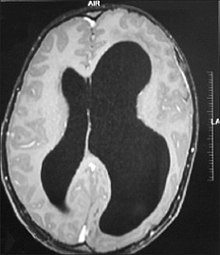Hemimegalencephaly
| Hemimegalencephaly | |
|---|---|
 | |
| Left-sided hemimegalencephaly in a person with neurofibromatosis[1] | |
| Specialty | Neurology, rheumatology |
| Symptoms | Frequent seizures often resistant to medicine |
| Usual onset | Congenital |
| Duration | Long term |
| Treatment | Hemispherectomy |
| Medication | Anti-epileptic drugs |
Hemimegalencephaly (HME), or unilateral
Symptoms and signs
Seizures are the main symptom. There can be as many as hundreds of seizures a day.[4] Seizures tend to begin soon after birth, but may sometimes commence during later infancy or, rarely, during early childhood.[5]
Other symptoms
- Asymmetrical or enlarged head[5]
- Developmental delay[5]
- Progressive weakness of half the body[5]
- Progressive blindness of half the body[5]
Genetics
Somatic activation of AKT3 causes hemispheric developmental brain malformations.[6]
Pathophysiology
It is a disorder related to excessive neuronal proliferation and
Diagnosis
It should be suspected in infants or children with intractable, frequent seizures.[4] On a CT scan, the affected part is distorted and enlarged.[9] It can be diagnosed prenatally, but a lot of cases go undiagnosed until seizures begin. Ultrasound can display asymmetrical brain hemispheres.[5]
Treatment
Although there have been a few reports of medical treatment, the main treatment is radical: remove or disconnect the affected side. However, it has a high mortality [recent citations needed], and there have been reports of a vegetative state and seizures resuming, this time in the healthy hemisphere.[10]
Surgery is usually performed as soon as possible to minimize damage caused by seizures. However, a trial with drugs can be attempted for a few months before surgery, and there is a slim chance of it succeeding.
References
- PMID 24799805.
- PMID 17416820.
- ^ "Hemimegalencephaly - Why hemispherectomy is usually required". www.brainrecoveryproject.org. Retrieved 2018-04-12.
- ^ a b "Gene Mutations Cause Massive Brain Asymmetry". UC Health - UC San Diego. Retrieved 2018-04-12.
- ^ a b c d e f "Hemimegalencephaly & Cortical Dysplasia". hemifoundation.homestead.com. Retrieved 2018-04-14.
- PMID 22500628.
- PMID 18687750.
- ISBN 978-0-08-055984-1.
- ^ Hennessy-Fiske, Molly (2012-06-15). "Radical surgery offers hope for baby racked by seizures". Los Angeles Times. Retrieved 2018-04-12.
- ^ S2CID 2442788.
- S2CID 45836490.
